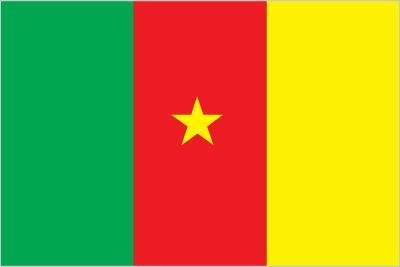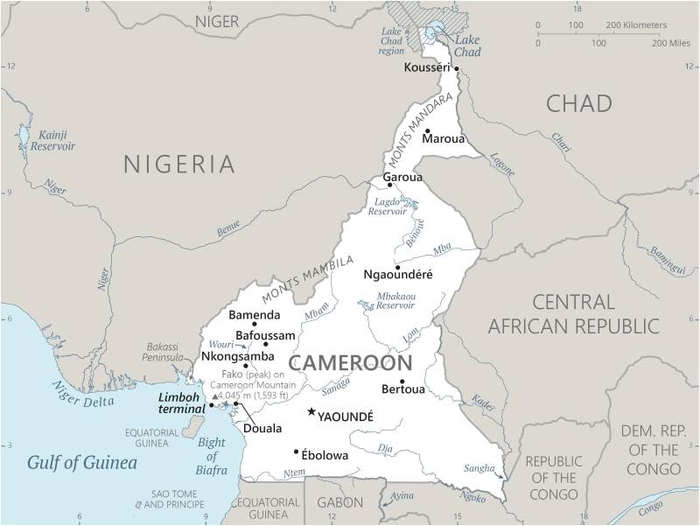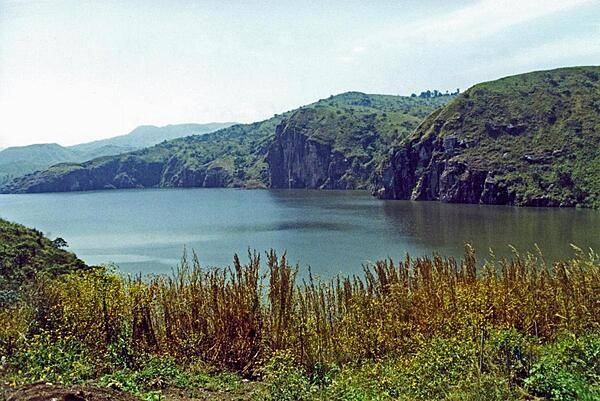184 Cameroon

Three equal vertical bands of green (hoist side), red, and yellow, with a yellow five-pointed star centered in the red band. The vertical tricolor recalls the flag of France. Red symbolizes unity, yellow the sun, happiness, and the savannahs in the north, and green hope and the forests in the south. The star is referred to as the “star of unity”.
Flag courtesy of the CIA World Factbook

Map courtesy of the CIA World Factbook

Lake Nyos is a crater lake on the flank of an inactive volcano. Magma beneath the lake leaks carbon dioxide into the waters. In 1986, the lake emitted a large cloud of carbon dioxide that suffocated nearly 1,800 people and some 3,500 livestock in nearby villages.
Photo courtesy of the CIA World Factbook
Government
According to Britannica, Cameroon’s constitution has undergone various developments since the country achieved independence. The constitution of 1961 linked the states of West Cameroon and East Cameroon together into a federation. The constitution of 1972, subsequently revised, replaced the federation with a centralized government. The constitutional revision of 1996 provided for the establishment of a bicameral legislature, although a second body was not created until 2013, and, to a minor extent, decentralized the government.
Executive powers are conferred upon the president, who serves as chief of state and head of the armed forces; the president also appoints a prime minister and a cabinet. The president is elected to a seven-year term by direct universal suffrage. A controversial constitutional amendment promulgated in 2008 eliminated presidential term limits and granted immunity to the country’s president for any acts committed in an official capacity during the president’s time in office.
Legislative power is vested in the bicameral parliament, consisting of the National Assembly and the Senate. The 180 members of the National Assembly are directly elected for five-year terms. The Senate is composed of 100 members. Each of the country’s 10 regions is represented by 10 senators, 7 of whom are indirectly elected while the remaining 3 are appointed by the president. Senators serve five-year terms.
For administrative purposes, Cameroon is divided into 10 régions. Prior to 2008, the country was divided into 10 provinces (coterminous with the current régions), which were administered by a governor appointed by the president. The 1996 constitutional revision addressed, albeit nominally, popular demand for decentralization of the government; that was the impetus for provinces being replaced in 2008 by régions, which were supposed to be administered by councils composed of indirectly elected members and representatives of traditional leaders. However, the regional councils were not in place at the time the régions were introduced and more than a decade later still had not been implemented.
Although the constitution calls for an independent court system, in practice the president has a powerful role in judicial appointments. The legal system of Cameroon consists of the Supreme Court, Courts of Appeal, and tribunals. Among its functions, the Supreme Court passes judgment on appeals concerning administrative actions of the government and decisions of the Courts of Appeal and the lower courts. The Court of Impeachment passes judgment on the president in case of high treason and on other government ministers in the event of a plot against the government. The Constitutional Council is concerned with matters pertaining to the constitution.
Cameroon Civil Aviation Authority (CCAA)
In order to meet the international requirements of states to fully assume its role in the regulation of safety and security of civil aviation, the Cameroon Civil Aviation Authority (CCAA) was created following the advent of the Law on Civil Aviation Regime N°98/023 of 24 December 1998, and its implementation decree N°99/198 of 16 September 1999. The CCAA is a public administrative establishment with legal personality and financial autonomy. The founding texts which allowed the creation of the CCAA, contributed to their adjustment. Following the enactment of the law on the regime of civil aviation in Cameroon No. 2013/010 of July 24, 2013, and its implementation decree No. 2015/232 of May 25, 2015, whose basis is the organization and functioning of the CCAA. In 2018 and 2019, two presidential decrees extended the missions of the CCAA. The structure is placed under the technical supervision of the Ministry of Transport, and under the financial supervision of the Ministry of Finance. The CCAA is the secular arm of the government in terms of coordination and monitoring of civil aviation activities in the national territory.
Airspace
SkyVector – Google Maps – ADS-B Exchange
ICAO countries publish an Aeronautical Information Publication (AIP). This document is divided into three parts: General (GEN), En Route (ENR) and Aerodromes (AD). ENR 1.4 details the types of airspace classes they chose to adopt from classes A through G.
Drone Regulations
Advanced Air Mobility (AAM) Regulations & Policies
None found by the author.
However, should you, the reader, happen to stumble across something to the contrary, please email the author at FISHE5CA@erau.edu and you may be mentioned in the ACKNOWLEDGEMENTS section of this book by way of thanks for contributing to this free eBook!
Advanced Air Mobility (AAM) News
None found by the author.
However, should you, the reader, happen to stumble across something to the contrary, please email the author at FISHE5CA@erau.edu and you may be mentioned in the ACKNOWLEDGEMENTS section of this book by way of thanks for contributing to this free eBook!
Short Essay Questions
Scenario-Based Question
You have been hired by a Drone Startup Company. Your boss has immediately assigned this job to you.
They need you to prepare a one-page memo detailing the legalities of using a drone to film Lake Nyos in Cameroon, pictured above.
They need you to mention any national laws and local ordinances.
They specifically want to know what airspace (insert pictures) you will be operating in and whether or not you need an airspace authorization.
Does it matter whether or not you are a citizen of the country?
Lastly, there is a bonus for you if, as you scroll through this chapter, you find any typos or broken links!
Short Essay Questions
- What are the drone categories?
- How is registration addressed?
- How is remote ID addressed?
- What are the model aircraft rules?
- What are the commercial drone rules?
- Are there waivers or exemptions to the rules? If so, for what?
- Would you share a link to an interactive airspace map?
- How is BVLOS addressed?
- How can you fly drones at night?
- How can you fly drones over people?
- Where do you find drone NOTAMs?
- What are the rules for drone maintenance?
- What are the rules for an SMS program?
- What are some unique rules not mentioned above?
- What are the C-UAS rules?
- What are the AAM rules?

